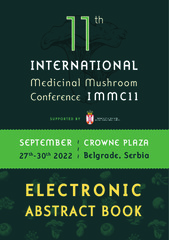Приказ основних података о документу
Mushroom polyphenols as immune system balancers: What's the mechanism behind it and possible interactions with dietary fibers?
| dc.creator | Kozarski, Maja | |
| dc.creator | Pantic, Milena | |
| dc.creator | Lazic, Vesna | |
| dc.creator | Klaus, Anita | |
| dc.creator | Vunduk, Jovana | |
| dc.creator | Griensven, Leo | |
| dc.creator | Niksic, Miomir | |
| dc.date.accessioned | 2023-12-07T13:50:46Z | |
| dc.date.available | 2023-12-07T13:50:46Z | |
| dc.date.issued | 2022 | |
| dc.identifier.uri | http://aspace.agrif.bg.ac.rs/handle/123456789/6543 | |
| dc.description.abstract | Mushroom polyphenols have been proposed as a new therapy that can improve the immune system. Different immune cells express multiple types of polyphenol receptors that recognize and allow cellular uptake of polyphenols, which subsequently activate signaling pathways to initiate immune responses. Polyphenols can be useful for immunocompromised patients with malignancies, viral or bacterial infections and chronic disorders of organ systems, as well as for those whose immunity is naturally weakened. Cosmetic formulations rich in mushroom polyphenols have the potential to regulate inflammatory skin disorders, as well as eczema or atopic dermatitis and photocarcinogenesis. As primary antioxidants, polyphenols have an important role in preserving immune cells in a reduced environment and in protecting them against oxidative damages and immunosuppression as well as maintaining their suitable function. As signaling pathway modulators, mushroom polyphenols can affect immune cell regulation, cytokine synthesis, and gene expression, in both innate and adaptive immune responses. There are different pathways in the integrated immunomodulatory polyphenol response, such as: 1) the nuclear NF-κB signaling pathway leading to suppression of various inflammatory cytokines expression, and enzymes such as COX-2; 2) MAPK signaling pathways that play a key role in many fundamental cellular processes such as cell growth, proliferation, death and differentiation, and also regulate gene transcription and the activity of transcription factors involved in inflammation; 3) arachidonic acid signaling pathway leading to a decrease in the release of inflammatory mediators; and 4) the Nrf2 / ARE signaling pathway involved in the activation of genes encoding cytoprotective and antioxidant enzymes. Given that polyphenols represent great potential in the design of immune-boosting formulations in line with their widespread structural diversity, it should be noted that some functionality issues require further clarification. For instance different observations and conclusions were reported by the scientists in absence of enzymes involved in their biosynthesis steps. Concerning the dietary application of mushroom polyphenols, it is necessary to mention that after oral consumption they are recognized by the human body as xenobiotics and often a small amount is absorbed in the intestine. Likewise, there are significant differences between the activities of the metabolic form of phenols and their form in the mushroom nutraceutical matrix. For an example, dihydoferulic acid, a metabolite of the ferulic acid, expresses anti-inflammatory activity, opposite to metabolites derived after sulfation and glucuronidation. The scientific focus is on improving and increasing polyphenols bioavailability by designing colloidal systems and using nanosystems. Moreover many studies have found that polyphenols can interact with macromolecules like dietary fibers, i.e. chitin and β-glucans. It has been shown that these interactions can affect the bioaccessibility of polyphenols in a food matrix as well as in nutraceutical formulations. Therefore, chitin and β-glucans have an impact on polyphenols’ immunomodulating activities if they were applied together in commercial formulations. Another disadvantage in the commercialization of polyphenol-based formulations is quantitative and qualitative variations in their content among different mushroom species. As secondary metabolites with a protective role e.g. phenols, their content in mushrooms depends on the locality and environmental conditions of growth. Using extracts or preparations that are based on mycelia grown under controlled conditions may be the solution for the reduction of the natural variability in polyphenol composition. Integrated information on all aspects of functionality will confirm the use of polyphenol-rich mushroom formulations as effective enhancers of immunity. | sr |
| dc.language.iso | en | sr |
| dc.relation | info:eu-repo/grantAgreement/MESTD/inst-2020/200116/RS// | sr |
| dc.relation | info:eu-repo/grantAgreement/ScienceFundRS/Ideje/7748088/RS// | sr |
| dc.rights | openAccess | sr |
| dc.rights.uri | https://creativecommons.org/licenses/by/4.0/ | |
| dc.source | 11th International Medicinal Mushroom Conference (IMMC11) | sr |
| dc.subject | mushrooms | sr |
| dc.subject | polyphenols | sr |
| dc.subject | immunomodulators | sr |
| dc.subject | nutraceuticals | sr |
| dc.subject | natural cosmetics | sr |
| dc.title | Mushroom polyphenols as immune system balancers: What's the mechanism behind it and possible interactions with dietary fibers? | sr |
| dc.type | conferenceObject | sr |
| dc.rights.license | BY | sr |
| dc.identifier.fulltext | http://aspace.agrif.bg.ac.rs/bitstream/id/25069/bitstream_25069.pdf | |
| dc.identifier.rcub | https://hdl.handle.net/21.15107/rcub_agrospace_6543 | |
| dc.type.version | publishedVersion | sr |


